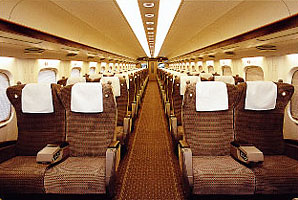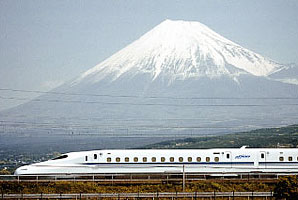Special Feature![]() Travel Japan by Train
Travel Japan by Train
Japan’s Bullet Trains Keep Evolving
The Shinkansen network is now the backbone of Japan’s rail transportation system. Bullet trains began operating more than 40 years ago and have kept evolving since then, reaching a new height with high-tech cars unveiled in 2007.
Written by Sanada Kuniko Photos by Hirota Naotaka, Hirota Izumi
Other photo credits: Central Japan Railway Company, Railman Photo Office

Tokaido/San’yo Shinkansen: Series N700 Nozomi rolling stock
Built for speed, rider comfort and energy savings. No wonder it was a hit as soon as it was unveiled.
The Shinkansen bullet train was a momentous development in rail transport when it began operating in 1964, the year Japan hosted the Tokyo Summer Olympics. The Series 0 railcars, with their trademark bullet-shape, ran on their own separate track on the brand-new Tokaido Shinkansen Line between Tokyo and Osaka. In those early days, they boasted a maximum speed of 220 km/h, giving Japan the honor of having the world’s fastest trains. Before long, they were running on the San’yo Shinkansen Line as well, from Shin-Osaka to Kyushu in the west.
The network began spreading to other parts of Japan around 1985, and this spurred the development of different Shinkansen train shapes and configurations, including double-decker cars, lower cars, and elegant, long noses for the end cars. In the 1990s, the Series 500 rolling stock raised the bar to a maximum speed of 300 km/h. And in July 2007 the latest generation of railcars—the Series N700—entered service on the Tokaido and San’yo Shinkansen lines.
The most impressive features of the Series N700 train are its amazingly fast acceleration (from standstill to 270 km/h in about 3 minutes), its outstanding rider comfort, and its low energy consumption. Many of the latest technologies went into its development, including a new tilting mechanism that uses air springs between the car bodies and the wheels to tilt the cars a little into the curves on the track. A tilt of just 1 degree lets trains negotiate bends without decelerating from the regular operating speed of 270 km/h. Without affecting rider comfort at all, the tilt has shaved five minutes off the travel time between Tokyo and Shin-Osaka.
The “Aero Double Wing” design for the front and back of the train looks something like a bird with its wings outstretched. There is a good reason for the unusual shape: it reduces air resistance, and this means less electricity consumption, a whopping 49% less than the electricity used by the original Series 0 trains when running at a lower speed of 220 km/h. The new trains have ergonomically designed seats for better comfort, and more than half the seats have electric outlets. Attention to passenger con-venience goes even further—for example, the multi-purpose cubicles equipped with aids for changing a baby’s clothing.
Today, the Shinkansen network reaches many parts of the country, and it continues to expand. The bullet trains keep racing into the future, poised to evolve in ways we may find hard to imagine. ![]()


Above left: Seating for superior Green class passengers on a Series N700 train. The newly developed air springs and dampers offer a smoother ride.
Above right: Series N700 train passing Mount Fuji on the Tokaido Shinkansen Line.